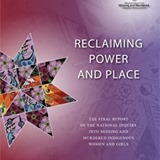My reflections continue with Chapter 2. I was struck by the idea that the value of our women is demonstrated by the profound impact of their absence. Women are the hearts of our communities and their gifts are crucial to community wellness.
We who have lost loved ones carry their voices forward so that others may hear our collective sorrow and glimpse the lost potential.
It is important to appreciate that Indigenous laws include principles that come from their understanding of the world and relationships. Laws are linked to the idea of inherent rights and aimed at generating conditions for greater peace and order. Canada failed to recognize that Indigenous rights were inherent and inalienable. (p. 134)
The principles about women’s roles are based on three values: Respect – honoring other living beings and acknowledging their contributions, Reciprocity – give and take with everything linked and connected, and Interconnectedness – recognizing everything and everyone has a purpose and place within the circle of life. Laws were dynamic and lived in community to ensure survival and harmony.
Traditional Stories of Indigenous Women offered both instruction and medicine – teaching peace, safety, dignity, justice and wisdom. Roles and responsibilities were indivisible and could not be upheld without culture and family. These included:
- Women as Creators – The mother-child bond represents people and their land. (p.149)
- Women in Leadership – Women are life-givers, water carriers, keepers of sacred ceremonies. (p.152)
- Women as Healers – Caring for all aspects of a person’s health – physical, mental, emotional, & spiritual. (p.154)
- Women as Providers – Food production, water keepers, land defenders (p.157)
- Women as Protectors – Many continue this work today. (p.160)
The disappearance of so many Indigenous women and girls has thrown entire communities out of balance. Indigenous women traditionally maintained the right to live free from violence, a sense of power not shared by European women. First Nations were land-based people, land representing Mother Earth. Colonizing Europeans interfered with this land stewardship. Colonization also diminished the roles of women, silenced their leadership and replaced respectful role modelling with hierarchical authority. (p.166)
Western culture had typically NOT promoted the culture of its women, unlike Indigenous culture where Creation was understood within the context of childbirth. Indigenous cultures also embraced gender and sexual diversity, where people had space to follow their own vision and path.
In summary, we must understand the roles, responsibilities and inherent rights conveyed by women and for women in their own terms. They are represented in land, stories, ceremony, and world views that emphasize the importance of collective and individual relationships. The sacredness of Indigenous women and girls, in their roles as teachers, leaders, healers, providers, and protectors, remains indispensable to generating solutions.


